Showdown: Kawasaki Ninja 1000 SX Vs Suzuki GSX-S1000GT+

A clash between two sport-touring heavyweights
It seems like all the splash lately has been about the ADV category and all the wonderful things they can do and destinations they can reach. We’re not going to deny adventure bikes their time in the sun, either. They’re definitely fun and capable bikes worthy of all the bandwagoning.
2023 Kawasaki Ninja 1000 SX vs. Suzuki GSX-S1000GT+
2023 Kawasaki Ninja 1000 SX
+ Highs
- The sportier of the two bikes, especially in the tight stuff
- Great wind protection
- Well padded seat
– Sighs
- Tighter confines could be a problem for tall riders
- Awkward saddlebag shape
- Tall gearing doesn’t let the bike’s true performance shine
2023 Suzuki GSX-S1000GT+
+ Highs
- Fantastic engine and an even better quickshifter
- Incredible bang for the buck
- More usable saddlebags
– Sighs
- Prefers long sweepers over tight corners
- Brakes need stronger pads (same with the Kawi)
- The seat’s a little hard
Meanwhile, for all the capabilities manufacturers have given to ADV bikes, it seems as though another category has had to make way for this growing popularity. Enter the lowly sport-touring motorcycle. Before the ADV craze really took off, if you wanted to go long distances and include twisty roads along the way, either two-up or alone, these were the bikes you’d pick. Now we know what you’re thinking, “Hey, MOrons, sport-touring bikes suck in the dirt.” True, but it’s not like there are a lot of you taking a giant R1250GS Adventure, two-up and fully packed down, into the dirt.
If that describes you (be honest), then the sport-touring category deserves another look. For those who prefer to stay on pavement and chew through miles of twisty, sinuous roads, there’s a strong argument to be made that sport-touring bikes can’t be beat. You still get comfy ergos, loads of tech, and decent fuel tanks, but crucially, you also get less suspension travel. Because while having the ground clearance to clear obstacles in the dirt is great, when you’re riding on pavement the long stroke is doing you a disservice. Keep it tight and lower to the ground, and the sportbiker within will thank you.
While all this fanfare about ADV bikes has thinned the sport-touring field, there are two that still stand out – the Kawasaki Ninja 1000 SX and Suzuki GSX-S1000GT+. In 2023 dollars, the Gixxus GT+ will cost you $13,799 while the Ninja slots in at $13,199 – minus the saddlebags. That’s an extra $922.95. Then you also need the mounting kit ($29.95) and the One Key System ($62.95) for a total of $1,015.85 above the 2023 MSRP. Grand total? $14,214.85. Opt for another grand on top of that and you can get the Touring package which also includes power outlets, frame sliders, Now, Ninja 1000 diehards might notice our test model is a 2022, but we’re going to pretend it’s a ‘23 for these purposes since everything’s the same for ‘23 except colors and price. Both bikes are rightfully equipped to handle long days in the saddle and twisty roads with a change of clothes and a toothbrush in the bags.
So, that’s exactly what Ryan Adams and I set out to do (with Bossman Brasfield along to snap photos, buy us meals, and (mostly) keep us in check). On paper both bikes have a lot in common. So, before diving into our little road trip, it makes sense to look at the numbers for both bikes to see exactly what we’re dealing with here.
They’re The Same, But Different
On the surface, we’ve got two Japanese sport-tourers, each with four-cylinder engines arranged in a line, displacing 1000-ish cubic centimeters. Ish, you say? It’s here where we already start to see a little bit of separation. The Kawasaki’s inline-Four comes in at 1,043cc, whereas the Suzuki “only” displaces 999cc. The Ninja’s 77mm x 56mm bore and stroke is matched to an 11.8:1 compression ratio. Conversely, the Suzuki engine measures 73.4mm x 59.0mm, but tries to make up for its slightly smaller size with a 12.2:1 compression ratio. Of course, who can forget that the heart of the GT+ is based on the legendary K5 GSX-R1000 engine, giving it a sporting pedigree the Ninja can’t match. You’ll also see the Suzuki has a slightly longer stroke than the Kawi. In theory, this should help the engine’s torque numbers.
Sure, a sporting pedigree is great, but there’s no replacement for displacement – or is there? When we spun the drum on the Wrench Motorcycles dyno, the Kawi pumped out 120.5 horses at 9,900 rpm and 70.8 lb-ft of torque at 8,600 rpm to the Suzuki’s 125.4 horses at 10,400 rpm and 65.0 lb-ft at 9,700 rpm. These numbers are a little deceiving, though. Yes, the GSX-S makes more power, but it has to spin higher to get there, and it makes less torque than the Ninja. However, look at the dyno graph and you’ll see the overall curve between the two bikes is much more in the Kawi’s favor, with more power from top to bottom until you get close to the rev limits. I guess there really is no replacement for displacement (forced induction aside…).
Take into account how much weight each is lugging around, and the two basically come out even again, as the Ninja tipped our scales at 532 lbs full of gas and with both saddlebags empty. Meanwhile, the Suzuki weighed in at 524 lbs. What’s surprising is that, simply looking at both bikes beside each other, the GT+ is visibly longer than the Ninja. Its overall length of 84.2 inches is nearly two inches longer than the Kawi’s 82.7 inches. From a wheelbase perspective, the Suzuki’s 57.4 inches from center to center outstretches the Ninja’s 56.7 inches. While that may not seem like much, from the saddle it feels limousine-like. Subtle differences, like wheelbase and power numbers on paper, result in very different-feeling motorcycles in practice. We’ll elaborate in a minute.
Speaking of saddles, both bikes are fairly even when it comes to seat heights. The Ninja sits slightly higher at 32.1 inches versus the Suzuki’s 31.9 inches. So, if seat heights were going to be your deciding factor between the two, there’s really not much difference. That said, reach to the ground isn’t too bad. Both Ryan and I are 5-foot, 8 inches, and had no issues putting a foot on the ground. Both fuel tanks hold 5 gallons, and while they aren’t necessarily narrow, their shape can best be described as putting the rider in a natural position.
One of the big differences between Adventure-Touring bikes and Sport-Tourers, aside from the bigger wheels and longer suspension, is the electronics. You’ll find loads of electronic aids designed for off-road use that you simply don’t need when strafing pavement. Both the Ninja and GSX-S strip down the tech (at least compared to ADV bikes) to the essentials. Here you get traction control, ABS, bi-directional quickshifters, and cruise control. The Kawasaki takes it a step further with the onboard IMU that allows a little more sophisticated predictive TC and cornering ABS. Information is shown to you on TFT displays, but the Suzuki’s 5-inch screen is bigger with a better UI/UX.
Two Ways Of Skinning A Cat
Admittedly, I gave the Suzuki high praise in my First Ride Review, even saying Suzuki “nailed it” with this one. However, I was quickly brought back to earth by Johnny Burns, who pointed out the Ninja 1000 is a pretty solid package too, after he threw a leg over it and gave it a go. Naturally, the next step was to put them together and give them a whirl.
2022 Suzuki GSX-S1000GT+ Review – First Ride
2020 Kawasaki Ninja 1000SX Review – First Ride
The plan encompassed a two-day ride from our Los Angeles digs, down to the outskirts of the San Diego desert – Borrego Springs, to be exact – taking the fun roads as much as possible but throwing in the boring stuff where necessary.
It’s the initial freeway stretch where the ergonomic differences start to stand out. Being the physically smaller bike, the Kawasaki also feels a little more compact than the Suzuki. Its bars are narrower and your legs have a little more bend in the knees. Between them, the Kawi’s pegs are 14.5 inches from the ground with 17.5 inches between the seat and pegs. The Suzuki is 0.5 inches and 1.5 inches lower and longer, respectively. In layman’s terms, the Suzuki gives you a more comfortable riding position with wider bars to boot.
As Ryan put it:
The GT+ will fit bigger folks more comfortably while the Kow displays the same narrow bar position that I’ve come to detest after so many comparisons of other models from Team Green (this seems to be a familial trait). The Ninja’s bars are closer and the footpegs are higher resulting in a more cramped riding position compared to the GSXS; you’ll also find the heel room cramped if you ride with the pad of your hooves on the footpegs.
This doesn’t mean the Kawasaki is necessarily uncomfortable. Especially if you’re average height. I personally found the seat to be better padded for longer stints in the saddle. Plus it has an adjustable windscreen, which the Suzuki does not. In its highest position, the windblast would flow nicely over my helmet – which was nice for the brisk morning air we were riding in. Since it’s not adjustable, the Suzuki’s screen directed air lower towards my neck and chest.
However, there’s a caveat with the Kawi’s screen. The tab you need to depress in order to adjust the screen is below the gauge cluster, buried behind the brake fluid reservoir and the various hoses and cables that take up the front of a motorcycle. It’s a little cumbersome to get to and requires both hands to depress it and move the screen. It’s so obnoxious that the single warning sticker placed on the gas tank features three bullet points, all pertaining to adjusting the windscreen safely – and while not moving. Design flaw, perhaps?
The Ninja, with its 120 horses, 70 torques, and broad spread of power, moves along just fine and has plenty of grunt. But it’s odd that, despite the bigger engine, it really kicks into life the higher the engine is spinning. Conventional wisdom would have you think the bigger engine’s torque would be more apparent. Not here. In traditional Kawasaki fashion, the Ninja must be geared quite tall, enough so to negate the feeling of torque from the saddle. But once the engine is singing you better hang on because it’s deceptively quick. The bi-directional quickshifter also comes into its own as the revs pick up, and it’s here where you start to feel some of that Ninja heritage come through.
However, for as exciting as the Kawasaki is, the Suzuki engine – and quickshifter – are the clear winners here. Despite the real-world power disadvantage (at least on paper), somehow Suzuki has managed to take a 17-year-old engine and make it feel more lively than the dyno would indicate. This is a perfect example of a dyno chart not being representative of reality, as both Ryan and I continually gravitated towards the Suzuki’s engine (and transmission) as being the more exciting of the two.
The reality is that we rarely, if ever, tapped into the Suzuki’s peak power advantage on our ride, and yet our butt dyno *felt* as though the GSX-S was the livelier of the two. We imagine shorter gearing makes the Suzuki’s slight torque disadvantage a non-issue – this despite being the smaller of the two engines. It’s truly impressive. You’ve got considerable grunt down low and an “exhilarating” top end, says Ryan.
From the moment the starter is pressed, the Suzuki engine roars to life with an aggressive purr that anybody who’s familiar with the GSX-R will recognize. Power delivery in A mode (the most aggressive) is still linear, as power builds quickly with just the right amount of buzz coming through the bars to excite and not annoy. Granted, a long enough drone on the highway will reveal buzz coming from both bikes, but each has cruise control to help give your hands a break.
I said it before in my First Ride Review, but it bears repeating just how good the Suzuki’s quickshifter is, in either direction. Some bikes work better at higher speeds or in higher gears, but Suzuki found a way to make every shift super smooth, especially from first to second or vice versa. It doesn’t sound like much, but it truly elevates the riding experience. Ryan agrees:
The smooth-operating Kawasaki inline four revs maturely to produce impressive forward thrust. If it weren’t for the most excellent low-end torque coming from the ol’ GSXS engine, I’d laud more praise on the Ninja, but the Suzuki mill is just as adept at cruising around town as it is being launched between apexes out in the canyons. Couple the strong GSXS engine with a solid transmission and one of the best quickshifters I’ve ever sampled and you’ve got a combination that’s hard to beat – and isn’t in this comparison.
Both engines are clearly well balanced for highway cruising, but they also like to embrace the sporty nature of sport-touring. Despite our best efforts, both bikes are dead even when it comes to efficiency, as we got an average fuel economy of 38 mpg for the Kawasaki and 37.9 mpg for the Suzuki. You’ll find five-gallon tanks on each bike as well, so neither really has an advantage when considering the touring aspect of sport-touring. You’ll be looking for gas stations at around the same time.
When it comes to the sport in sport-touring, well, we’ve got a mixed bag. The Kawasaki, with its shorter wheelbase and slightly steeper rake angle (24.0º vs. 25.0º on the Suzuki), is the quicker steering of the two and favors tighter turns relative to the GSX-S. With that in mind, being longer and a little lazier, the Suzuki prefers long sweepers where it has room to settle in. Quick transitions are not its strong suit, despite its wide bars.
The big caveat here is that both bikes are let down by their 190/50 rear tires. Producing a nearly flat profile, the 190/50 is nearly as flat a profile as a car tire and this hampers cornering severely. Both Ryan and I noticed both bikes being hard to initiate a turn – so much so that we thought we loaded the saddlebags unevenly at first to cause this weird sensation. Once we realized this was just a character trait of the flat-profile tire, we begrudgingly carried on. Our advice? Ditch the 190/50 tire immediately and replace it with a 190/55 (or 190/60, if that exists). The rounder profile will transform both bikes.
Nonetheless, the Kawi generally favors the sporty side of sport touring while the Suzuki leans the other way – at least when it comes to the kind of twists and turns each bike excels in. As Ryan points out:
The Kawi is a plush tourer, the Zook is sport. Adjustability is available for both bikes. In the standard settings or even when closing the damping, the Ninja delivered a cushy ride. The Suzuki felt stiffer throughout, which was preferred during the ripping and tearing, but not as much on tight rough asphalt.
Irony sets in when we note how the Kawasaki’s suspension steered toward plushness while the Suzuki tried to channel more of its GSX-R heritage with a firmer, sportier ride. Both bikes give you adjustable suspension, but when it came time to try and firm the Ninja for the canyons, imagine our surprise when the Kawi shock only gave us three turns of rebound adjustment. Three turns. Effectively, this means the shock rebound circuit is either wide open or fully closed.
Not to mention that you don’t get compression adjustability anyway. As such, the Ninja felt unbalanced front to rear. For the Suzuki’s part, even though the ride was firmer than the Kawasaki, both ends felt balanced with each other.
What speeds up must slow down, and the braking systems on each bike can best be described as…adequate. I’ll let Ryan explain:
That’s highway rubbery! The Ninja’s rubber lines remind me of off-road brake systems where the initial bite is softened on purpose, but plenty of power and feel is available. The Suzuki’s front brake had a little more initial bite but then felt fairly wooden afterward. We adjusted the lever a bit which seemed to help, but a brake pad swap might alleviate the problem entirely.
Both bikes have radial-mount calipers with four pistons – the Suzuki even has Brembos – but neither braking system really blew us away. From a tech standpoint, the Ninja’s cornering-ABS should be more impressive, but it’s not like we slammed either set of brakes in the middle of a corner to avoid anything. Fortunately, we were already upright by the time we encountered the jive turkeys in the middle of the road (true story).
While we’re on the topic of C-ABS, let’s talk about tech a little more. For sport-touring bikes especially, where road conditions can vary widely as you travel, we’re big fans of traction control and C-ABS. Early morning start times can mean chilly, slippery roads, and we’ve used ABS on both bikes. If we’re to nitpick, the Suzuki’s less refined system shows through in the pulsing at the lever. But again, that’s a fine hair we’re splitting.
What’s not up for debate is which TFT screen is better. The Suzuki wins this round. As Ryan explains:
Both bikes have nice TFT displays, but the GT+’s is bigger, which I’m told is better. Navigating both was easy enough; the Kawasaki’s took more time to learn, but anyone spending much time with either bike will get things figured out easily enough. The ability to tailor ride modes and settings is there on both bikes, but the Ninja displays your right and left lean angle for bragging rights. We saw a max left lean angle of 80 degrees (on the street, in front of Evans’ house). Top that!
Personally, not only did I find the Suzuki screen much cleaner and easier on the eyes, but it was easier to navigate. Sure if you own either bike you’ll eventually figure out the navigation nuances, but the Kawasaki’s menu screens are not at all intuitive and require an annoying amount of button pressing to sort through. As far as UI/UX points are concerned, the Kawasaki’s not getting any.
Of course, sport touring is about more than just corner carving. You also need to carry stuff, too. Both sets of bags can swallow a medium full-face helmet, but both Ryan and I gravitated towards the Suzuki’s bags for a few reasons. First, the shape of the Kawasaki’s bags have sharper angles to align with the rear end styling of the bike. These sharp angles come at the expense of interior space for smaller items you might want to stuff in your bag, like a water bottle, toiletry bag, or communicator box, for example. The GSX-S bags are angled too, but not as sharply as the Ninja’s. Though the Suzuki’s lid is slightly shallower, meaning you can’t place as many items in it to try and stuff into the pannier as it closes.
The main reason we like the Suzuki’s bags better is because they don’t make us fear that they’re about to fall off at any moment. As Ryan notes, “While the Kawasaki luggage was smooth and easy to use, I could hear it rattling around at the mounting point any time I went over rough terra. The Suzuki panniers felt more solid in their mounting and were easy to remove.”
Lastly, we turn to looks. Beauty is in the eye of the beholder, of course, and it’s not often we even mention appearances in these tests. Still, if you were to own one of these then you’re going to have to look at it pretty regularly. Personally, the GSX-S isn’t going to win any beauty contests, and I slightly prefer the Ninja’s looks better, but I’m more than willing to overlook aesthetics if I like the ride better – and in this case, I do.
As for Ryan, here’s what he had to say, “I’m a big fan of the Suzuki styling because it’s somewhat odd. Suzuki hasn’t exactly pushed the boundaries of style in some time, so I appreciate the new styling in the GSXS line. The Ninja 1000 is classic Kawasaki sport, so if you’ve always liked the sporty look, the Ninja continues to deliver.”
What’s Our Pick?
If you’ve read this far then you should already know which one we’d choose between these two. Both the Kawasaki and Suzuki are closely matched in many areas, and yet, they’ve also formed their own identities. The Kawi veers more towards sport, the Suzi towards touring – even though both would benefit enormously from a rounder rear tire profile. The Kawi would lean into its sporting side even more, but I think the Suzuki would crossover and find more of its GSX-R heritage, too.
As is always the case, we can only review the bikes we’ve got. In this case, we liked the Ninja’s comfort and agility, but as capable as both of them are in this sport-touring game, the Suzuki’s livelier engine, fantastic quickshifter, (slightly) better saddlebags, and balanced chassis ultimately won us over.
Sport touring is not dead, folks.
Ryan’s Gear
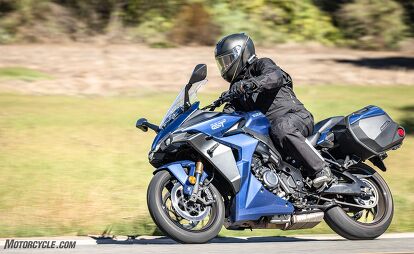
- Communicator: Cardo Packtalk Edge
- Suit: Aerostich Stealth R-3 One Piece Suit
- Airbag: Alpinestars Tech-Air 5
- Gloves: Racer Mickey Glove
Boots: Dainese Axial D1 Air Boots
Troy’s Gear

Helmet: Arai Regent-X
- Communicator: Cardo Packtalk Edge
- Suit: Aerostich R-3 One Piece Suit
- Airbag: Alpinestars Tech-Air 5
- Gloves: Alpinestars SP-2 v2
Boots: BILT Evolution Boots
Scoreboard | 2022 Kawasaki Ninja 1000 SX | 2023 Suzuki GSX-S1000GT+ |
|---|---|---|
| Price | 97.1% | 100% |
| Weight | 98.5% | 100% |
| lb/hp | 95.5% | 100% |
| lb/lb-ft | 100% | 92.6% |
| Total Objective Scores | 97.8% | 98.8% |
| Engine | 90.0% | 96.3% |
| Transmission/Clutch | 80.0% | 95.0% |
| Handling | 87.5% | 82.5% |
| Brakes | 75.0% | 75.0% |
| Suspension | 77.5% | 80.0% |
| Technologies | 80.0% | 82.5% |
| Instruments | 80.0% | 92.5% |
| Ergonomics/Comfort | 85.0% | 85.0% |
| Quality, Fit & Finish | 85.0% | 88.8% |
| Cool Factor | 80.0% | 85.0% |
| Grin Factor | 80.0% | 90.0% |
| Troy’s Subjective Scores | 81.2% | 85.8% |
| Ryan’s Subjective Scores | 83.9% | 89.0% |
| Overall Score | 85.4% | 89.5% |
Specifications | 2022 Kawasaki Ninja 1000 SX | 2023 Suzuki GSX-S1000GT+ |
|---|---|---|
| MSRP | $13,199 ($14,214.85 as tested) | $13,799 |
| Engine Type | 1043cc liquid-cooled inline-Four, DOHC, 4 valves-per cylinder | 999cc Liquid-cooled, 4-stroke Inline-Four |
| Bore and Stroke | 77.0 x 56.0 mm | 73.4 x 59.0 mm |
| Compression Ratio | 11.8:1 | 12.2:1 |
| Horsepower | 120.5 hp at 9,900 rpm | 125.4 hp at 10,400 rpm |
| Torque | 70.8 lb-ft. at 8,600 rpm | 65.0 lb-ft. at 9,700 rpm |
| Transmission | 6-speed | 6-speed; wet multiplate clutch |
| Final Drive | Chain | Chain |
| Front Suspension | 41mm inverted fork; adjustable for spring preload, rebound and compression damping, 4.7-inches of travel | KYB 43 mm inverted telescopic fork, fully adjustable, 4.72 inches of travel |
| Rear Suspension | Horizontal single shock; hydraulic spring preload adjuster, rebound damping adjustability, 5.4-inches of travel | Link type KYB shock, fully adjustable, 5.12 inches of travel |
| Front Brake | Dual 300mm discs, radial-mounted four-piston calipers; lean-sensitive ABS | Dual semi-floating 310mm discs with Brembo radial-mount 4-piston calipers, ABS |
| Rear Brake | 250mm disc; lean-sensitive ABS | Single 240mm disc with single-piston caliper, ABS |
| Front Tire | 120/70-ZR17 | 120/70 ZR17 |
| Rear Tire | 190/50-ZR17 | 190/50 ZR17 |
| Rake/Trail | 24.0 deg/3.9 inches | 25.0 deg/3.9 inches |
| Wheelbase | 56.7 inches | 57.4 inches |
| Seat Height | 32.1 inches | 31.9 inches |
| Curb Weight (w/bags) | 532 pounds | 524 pounds |
| Fuel Capacity | 5.0 gallons | 5.0 gallons |
| Colors | Emerald Blazed Green/Metallic Diablo Black/Metallic Graphite Gray | Metallic Reflective Blue, Glass Sparkle Black |
| Warranty | 12 months, transferable; extended coverage available | 12-month, unlimited mileage limited warranty |
We are committed to finding, researching, and recommending the best products. We earn commissions from purchases you make using the retail links in our product reviews. Learn more about how this works.
Become a Motorcycle.com insider. Get the latest motorcycle news first by subscribing to our newsletter here.

Troy's been riding motorcycles and writing about them since 2006, getting his start at Rider Magazine. From there, he moved to Sport Rider Magazine before finally landing at Motorcycle.com in 2011. A lifelong gearhead who didn't fully immerse himself in motorcycles until his teenage years, Troy's interests have always been in technology, performance, and going fast. Naturally, racing was the perfect avenue to combine all three. Troy has been racing nearly as long as he's been riding and has competed at the AMA national level. He's also won multiple club races throughout the country, culminating in a Utah Sport Bike Association championship in 2011. He has been invited as a guest instructor for the Yamaha Champions Riding School, and when he's not out riding, he's either wrenching on bikes or watching MotoGP.
More by Troy Siahaan




























































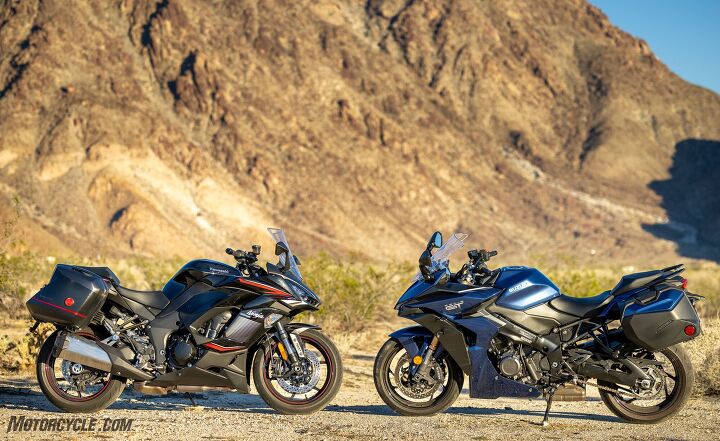
























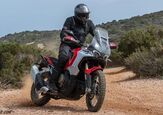




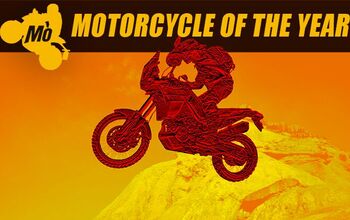
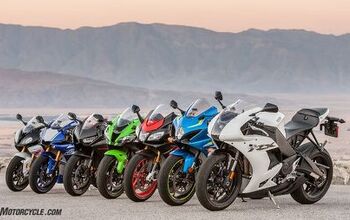

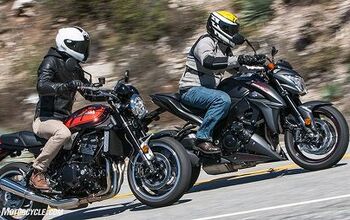










Comments
Join the conversation
Don't find the article as endearing as many others. Seems contradictory to say the Ninja is more plush and better for sport, and the Suz is more taught but better for the hwy, apparently based on 1 deg steeper rake and 0.7" shorter WB (yet more leverage from wider bars?), and the Suz's better bags. The listed weights for both and the dyno chart for the Suz don't seem to add up - will require more research. I thought the '22 model Suzy got the Euro 5 treatment, and the plain and GT models had the same engine.
These 2 are probably close enough for a coin flip, with adv Suz for the bags. I currently have 3 ST's - KTM 1290 SDR, Bandit 1250S, SV1000S. All 3 meet my needs with aftermarket shield as needed, tankbag and soft bags over the seat. They get trailered to good riding - no need to trudge across flat straight roads wearing out yourself and the bike. Too bad for those who think the need to buy an OEM ST with shaft drive - leaves a lot of great chain drive (I prefer - put on the gearing I want) standard/naked bikes for me to choose from. Its tough to take a few minutes to squirt a little chain lube each day, oh the stress of it all.
Love these articles and comparos! I have owned my GT since last May and have accumulated 4600 miles of just weekend rides. I find commuting on a motorcycle to be nothing but a chore. I prefer my motorcycling to be with friends going out and hitting the twisties and a weekend trip or two a year or more is awesome fun. I owned a 2014 Ninja 1000 and remember it being harder to handle in the twisties, maybe they made some changes. I am just tired of black or black and some small splash of other colors. I picked the GT because I thought the dark blue looked pretty awesome. I have a 190/55 and it seemed to help some. Next I plan to drop the front forks 5mm to see how that feels. As hard as I look on youtube and the internet, I still haven't found another bike that could replace it and do a better overall job for the money. I came from a bunch of sportbikes and prefer "some" wind protection and sporty looks. Now if Yamaha would make a faired "MT10", there might be something to consider. The Euro competitors are so plagued with reliability issues and expensive maintenance and repairs, so I pretty much ruled them out.